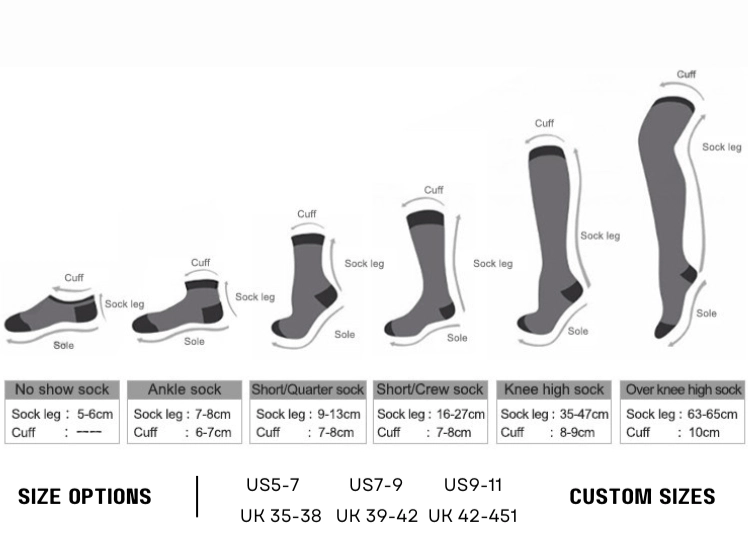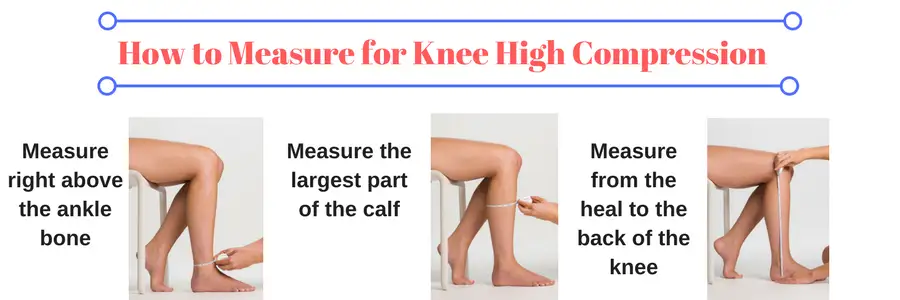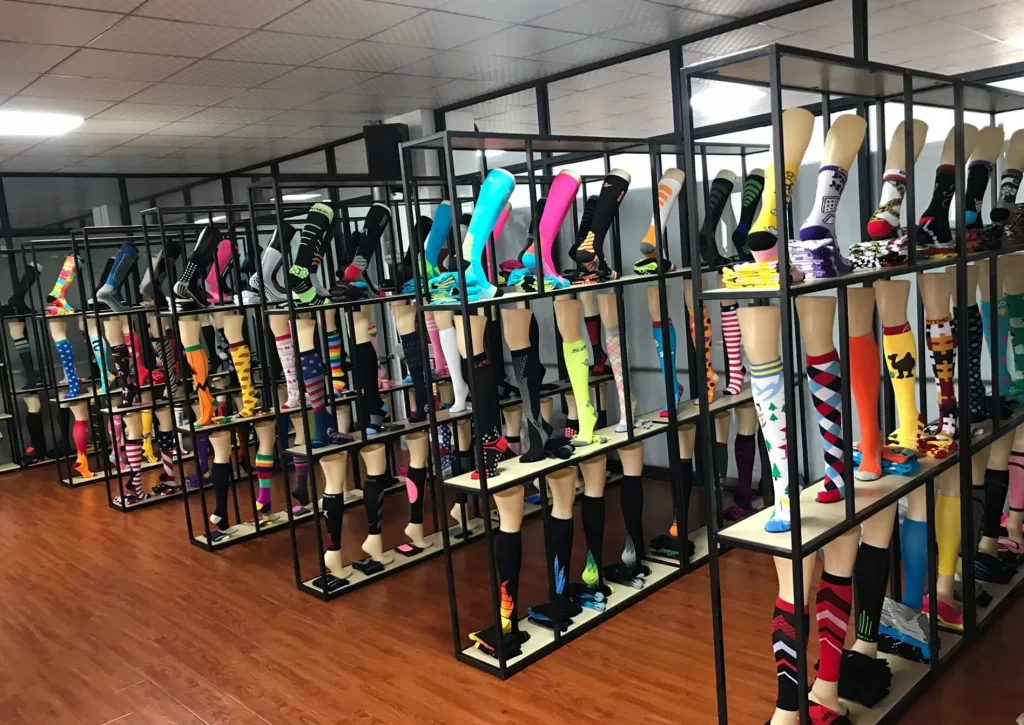Introduction
Getting the right size for compression socks is crucial for building trust and ensuring a smooth customer experience. As a brand or retailer, offering socks that don’t fit properly can lead to frustration, returns, and negative reviews, ultimately impacting your reputation. When sizing is accurate, your customers enjoy the comfort and benefits they expect, leading to higher satisfaction and repeat business. On the other hand, incorrect sizing can compromise the sock’s effectiveness, leaving customers disappointed and your brand at risk.
To find the right size, ignore your shoe size—compression socks are sized by limb measurements. Use a tape measure to find the circumference of your ankle and the widest part of your calf. For the most accurate fit, take these measurements in the morning and match them to the brand’s specific sizing chart.
This guide will show you how to properly size compression socks, how to avoid common mistakes, and why working with a reliable manufacturer can help you meet your customers’ needs. By getting the fit right, you can ensure your products perform as expected and strengthen customer loyalty.

Understanding Compression Sock Sizing Basics
Breaking Down mmHg: What Compression Levels Mean for Customers
When selecting compression socks, one of the most important factors to consider is the level of pressure they provide, measured in mmHg (millimeters of mercury). This unit determines how much pressure is applied to the legs, affecting circulation and overall comfort. The key to offering the right fit is understanding these pressure levels and how they align with your customers’ needs.
- Mild Compression (8-15 mmHg): Often used for everyday comfort and leg fatigue relief. These socks are ideal for customers who experience mild swelling or want to enhance circulation during long periods of sitting or standing.
- Moderate Compression (15-20 mmHg): Commonly recommended for individuals with varicose veins or those looking to prevent swelling during extended travel or exercise. This level provides better support for users dealing with more noticeable leg fatigue.
- High Compression (20-30 mmHg and above): Primarily used for medical purposes, such as post-surgery recovery or treating severe vein issues. It offers substantial support to ensure blood flow and reduce swelling, but should be worn under a doctor’s advice.
Key Metrics Brands Must Track: Calf, Ankle, Foot, and Height
Accurate sizing goes beyond just knowing the compression level. To ensure your compression socks fit properly, there are several key metrics to measure. These metrics are essential to creating a product that will meet your customers’ needs and provide the comfort they expect.
- Calf Circumference: This is the thickest part of the calf, and it’s critical for determining the right fit in the sock. For optimal comfort, the sock should fit snugly but not constrict, which is why measuring this area is so important.
- Ankle Circumference: The ankle, typically measured just above the ankle bone, is the narrowest part of the leg. Accurate measurement here ensures the sock won’t be too tight, which could hinder circulation, or too loose, which may reduce the sock’s effectiveness.
- Foot Length: To avoid discomfort, the length of the foot should be measured from the back of the heel to the tip of the longest toe. The right foot length ensures that the compression sock won’t be too long or too short, allowing for a better fit and performance.
- Height: The height of your customer’s legs affects how far the compression sock should extend. For full-length socks, it’s important to measure from the floor to the top of the calf to ensure the sock doesn’t slide down or bunch up during wear.
By carefully measuring these key areas, you can help your customers select compression socks that fit properly, ensuring they receive the benefits they expect and reducing the risk of returns or dissatisfaction.

How to Accurately Measure for Compression Socks
Getting the right fit for compression socks is not just about comfort—it directly affects how well the socks perform. Ill-fitting compression socks can lead to poor circulation, discomfort, or ineffective pressure distribution. For retailers, pharmacies, or clinics offering compression solutions, knowing how to guide customers through proper measurement is key to both satisfaction and outcomes.
Calf Circumference: The Anchor of Compression
Start by measuring the widest part of the calf, typically the area with the most muscle mass. Use a soft measuring tape, held flat against the skin without pressing too tightly. This measurement is critical for determining the sock’s upper tension zone. If it’s too tight, the sock can create a tourniquet effect; if too loose, the sock won’t stay in place or deliver adequate pressure. A well-measured calf circumference ensures the sock provides therapeutic support while remaining wearable for extended periods.
Ankle Circumference: The Compression Starting Point
Measure the narrowest part of the ankle, usually just above the ankle bone. This is where graduated compression begins. Since compression socks apply the most pressure at the ankle, accurate measurement here ensures optimal blood flow support. Overly tight compression at the ankle may restrict circulation; too loose, and the sock fails to deliver its primary medical benefit.
Foot Length: Stability and Comfort in Motion
Finally, measure from the back of the heel to the tip of the longest toe. The sock should match the foot length to prevent bunching or heel slippage. A correct foot length keeps the sock properly positioned during daily activities or prolonged standing.
Precise sizing at these three points—calf, ankle, and foot—ensures your compression socks function as intended, offering both performance and long-term wearability.
Compression Sock Sizing Chart: What Brands Need to Know
A reliable sizing chart is essential for determining the right fit for compression socks, which should account for calf, ankle, and foot length measurements. These charts typically list sizes such as small, medium, large, and extra-large, with corresponding ranges for each measurement. Some brands may also offer different charts for different sock styles (ankle-high, knee-high, etc.) or account for gender differences.
Ensure that your sizing chart includes specific ranges for calf circumference, ankle size, and foot length, as each of these factors influences the final fit of the sock.
How Compression Level Affects Sizing
Compression socks are available in different compression levels, which also influence the fit. For example:
- Mild Compression (8-15 mmHg): These socks are more flexible in sizing, offering a broader range of fits for general comfort.
- Moderate Compression (15-20 mmHg): These socks require a more accurate fit, as they provide targeted support for moderate swelling or varicose veins.
- Firm Compression (20-30 mmHg and above): These socks demand the most precise sizing to ensure effective and safe compression for medical use.
Understanding how sizing charts align with these compression levels will help you better guide customers in choosing the right product for their needs.
Comprehensive Guide to Choosing Compression Socks for Your Customers
Material Matters: Finding the Right Balance of Comfort and Durability
The material of compression socks directly influences their effectiveness and comfort. When selecting materials, you need to consider factors such as breathability, elasticity, and durability to meet your customers’ needs.
- Cotton: Known for its softness and breathability, cotton is comfortable for everyday wear. However, it lacks the stretch required to maintain consistent compression over time and may not offer the same level of support as other fabrics.
- Polyester and Spandex Blends: These materials are designed for higher elasticity and durability, making them ideal for compression socks that need to stay snug and provide effective support. Spandex gives the sock the stretch it needs, while polyester ensures the sock remains breathable and moisture-wicking, making it a great option for both athletic and medical purposes.
Choosing the appropriate material ensures that the compression socks not only perform well but also provide a comfortable wearing experience.
Style: Tailoring Compression Socks to Different Needs
Compression socks are available in various styles, each catering to specific needs. The right style can make a big difference in terms of comfort and support for your customers.
- Low-tube and Mid-tube Styles: These shorter socks provide moderate compression and are suitable for general use, such as reducing leg fatigue during daily activities or light exercise. They offer an easier fit and are often preferred for casual wear or short-duration activities.
- Full-length Compression Socks: These socks provide more extensive coverage and support, making them perfect for customers who need enhanced leg and ankle support, such as athletes or those recovering from surgery. Full-length options help improve circulation over a larger area and prevent swelling during longer periods of activity.
When selecting styles, consider your customers’ specific needs:
- Medical Use: Patients may need specific styles that offer targeted relief for conditions like varicose veins or severe swelling.
- Athletic Use: Athletes often require full-length compression socks for enhanced circulation during intense physical activity.
- Daily Wear: For daily comfort, low- or mid-tube socks are usually preferred due to their flexibility and ease of wear.
Compression Level: Matching the Right Compression to Customer Needs
The level of compression in socks varies, and selecting the right level is crucial for meeting your customers’ needs.
- Mild Compression (8-15 mmHg): These socks provide gentle compression, perfect for customers who need relief from light fatigue or those who spend long hours on their feet. They help with circulation without applying too much pressure, making them ideal for everyday use.
- Moderate Compression (15-20 mmHg): These socks are designed to offer targeted support for people with mild swelling or varicose veins. They provide a bit more pressure, helping to prevent and relieve discomfort caused by prolonged activity or travel.
- High Compression (20-30 mmHg and above): These socks offer significant support and are often prescribed for customers dealing with severe swelling or recovery after surgery. High-compression socks deliver firm pressure, but they should be used under medical advice to ensure they are appropriate for the user’s condition.
Matching the right compression level to your customers’ needs ensures they get the most effective solution, whether for comfort, recovery, or medical use.
Common Mistakes to Avoid When Sizing Compression Socks
Overlooking the Importance of Accurate Leg Measurement
A common mistake is underestimating the significance of precise leg measurements. Even a slight variation can lead to improper fit, which negatively impacts comfort and functionality. Without taking accurate calf, ankle, and foot measurements, your customers may end up with compression socks that either don’t provide enough pressure or are too tight. Both scenarios can compromise circulation or lead to discomfort, resulting in frustration and returns.
Taking the time to measure each area correctly ensures a snug, comfortable fit that maximizes the benefits of compression socks.
Choosing the Wrong Compression Level for the Customer’s Needs
Selecting an inappropriate compression level can also have detrimental effects. Compression socks come in various pressure strengths, and recommending the wrong level can leave your customers dissatisfied. For instance, mild compression may not be sufficient for customers with moderate swelling, while high compression may be too intense for those who only require light relief.
It’s crucial to understand the specific requirements of your customers and match the right compression level to their needs, whether it’s for general fatigue relief or more serious medical conditions. Offering guidance in this area can help customers make more informed choices and improve their experience.
How Improper Sizing Affects the Sock’s Effectiveness
Improper sizing not only affects comfort but also diminishes the effectiveness of compression socks. Socks that are too tight may cause discomfort or even exacerbate circulation problems, while socks that are too loose won’t provide the targeted support needed to relieve swelling or fatigue. To achieve the intended therapeutic benefits, it’s essential to ensure the socks fit properly and provide the right level of pressure across the calf, ankle, and foot. Ensuring the correct fit will help you avoid negative customer feedback and ensure that your compression socks are performing at their best.
Customizing Compression Socks for Your Brand: Tailoring Sizes to Your Customers
Offering a Range of Sizes to Meet Diverse Customer Needs
To meet the diverse needs of your customers, it’s crucial to offer a wide range of sizes. Providing small, medium, large, and extra-large sizes ensures that everyone can find the perfect fit, whether they need a snug compression for medical use or a more relaxed fit for daily wear. By offering multiple sizes, you can cater to different body types, ensuring your customers enjoy both comfort and functionality. This flexibility helps minimize returns and enhances overall customer satisfaction.
The Benefits of Customization for Brands and Retailers
Customization allows you to create compression socks that meet the specific needs of your target market. Whether for sports, healthcare, or fashion, custom compression socks can be designed with the right compression level, materials, and aesthetics to match the intended application.
- Sports and Fitness: For athletes, compression socks can be tailored to improve performance and accelerate recovery. Using breathable, moisture-wicking fabrics with moderate compression levels ensures comfort during exercise, while offering optimal support for muscles and joints.
- Healthcare: For medical applications, socks can be customized with stronger compression levels and materials that promote blood circulation and reduce swelling, providing relief for conditions like varicose veins or post-surgery recovery.
- Fashion: Compression socks have also become a stylish trend. Custom designs with unique patterns, colors, and branding can appeal to younger consumers who seek both comfort and style, creating a new market segment.
Customization adds value to your brand by offering products that are both functional and tailored to your customers’ specific needs, enhancing your brand’s appeal and increasing customer loyalty.
How Partnering with a Trusted Manufacturer Ensures Consistent Sizing
By collaborating with a reliable manufacturer, you can ensure that your compression socks are consistently sized and meet high-quality standards. Our factory specializes in large orders with precise control over sizing and compression levels, so you can provide your customers with a consistent fit. We use advanced technology to maintain quality throughout the production process, ensuring that your products perform as expected.

Working with us gives you control over the entire production process, from material selection to final packaging, helping you meet market demands quickly and efficiently. Whether you’re offering standard sizes or custom options for specific applications, you can trust us to deliver high-quality products that exceed customer expectations.
For more information on how compression socks can benefit your customers, visit our guide on all things compression socks to learn more and contact us today to order your custom compression socks. With our expertise and commitment to quality, you can confidently provide your customers with compression socks that meet their unique needs, ensuring both satisfaction and repeat business.
Conclusion: Ensuring the Perfect Fit for Your Customers
Getting the right size for compression socks is key to customer satisfaction. By understanding the right measurements, compression levels, and materials, you can offer products that fit well and perform effectively. Providing a range of sizes and customized options helps meet the unique needs of your customers.
Partnering with a trusted manufacturer ensures consistent quality and accurate sizing. At Jiaxing Max Hosiery Co., Ltd., we specialize in creating customized compression socks that fit perfectly and work as expected.
If you’re ready to offer your customers the best fit, contact us today. Let’s work together to create the perfect solution for your brand!
FAQs
Can you produce compression socks in various sizes?
Yes, we offer a range of sizes to ensure a perfect fit for your customers, from small to extra-large, catering to diverse needs.
Can your factory provide consistent quality for large orders of compression socks?
Yes, we maintain strict quality control throughout the production process to ensure consistent sizing and compression effectiveness. Our automated production line guarantees high-quality output with a quick turnaround.
What types of compression levels can you produce for different customer needs?
We can manufacture compression socks in various levels, from mild (8-15mmHg) for daily comfort, to high compression (20-30mmHg and above) for medical recovery. We tailor the compression strength to meet the specific needs of your customers.
What are the key advantages of ordering compression socks from your factory versus other suppliers?
We provide competitive pricing, quick turnaround, and reliable quality control. Our comprehensive customization options and excellent customer support make us a trusted partner.
How quickly can I receive a bulk order of compression socks from your factory?
We offer fast production, with samples ready in 2 days and bulk orders delivered in just a few weeks. We also provide global DDP delivery for quick and easy shipping.
